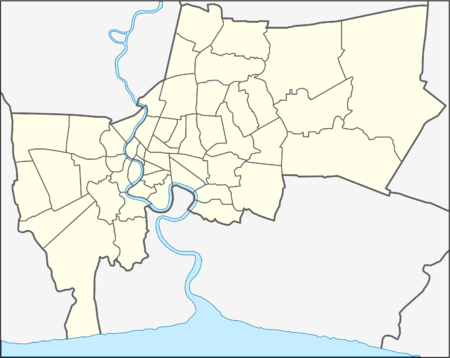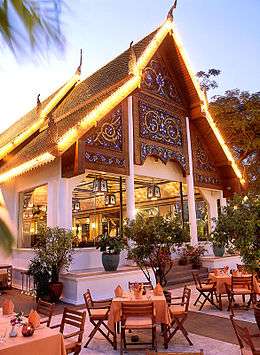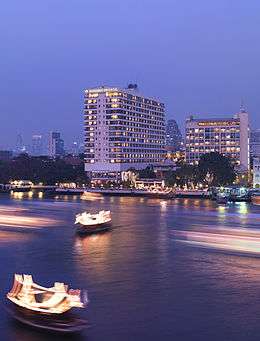Mandarin Oriental, Bangkok
| Mandarin Oriental, Bangkok | |
|---|---|
|
View of Mandarin Oriental, Bangkok across the Chao Phraya River | |
 Location within Bangkok | |
| General information | |
| Location | 48 Oriental Avenue, Bangkok 10500, Thailand |
| Coordinates | 13°43′25″N 100°30′52″E / 13.72361°N 100.51444°E |
| Opening | 1876 |
| Management | Mandarin Oriental Hotel Group |
| Other information | |
| Number of rooms | 393 |
| Number of suites | 35 |
| Number of restaurants | 8 |
| Website | |
| MandarinOriental.com/bangkok | |
Mandarin Oriental, Bangkok is a five-star hotel in Bangkok owned in part and managed by Mandarin Oriental Hotel Group. Located on the banks of the Chao Phraya River, the original structure was the first hotel built in Thailand when it opened as The Oriental in 1876. Today, the hotel is one of two flagship properties of Mandarin Oriental Hotel Group and is known for service, which consistently places it among the world's best hotels (see Awards).
History
When Siam opened to foreign trade after the signing of the Bowring Treaty the sailors that manned the ships which conveyed this trade though Bangkok required accommodation on shore. To meet this demand, Captain Dyers, an American and his partner J.E. Barnes opened a hotel called the Oriental Hotel. This burnt down in 1865.[1]
Several years later a partnership of Danish captains opened a replacement hotel.[2] In the 1870s the board of the Oriental Hotel decided with the opening of the new River Wing, upon 1876 as the official establishment date of the Oriental Hotel.
H. N. Andersen
In 1881 29-year-old Hans Niels Andersen, a Danish businessman, bought the premises.[3] His various business ventures led to him becoming a much respected member of the Western community in Siam. Andersen identified a need for a respectable hotel with good accommodation, a bar and a western menu to meet the needs of travellers and businessmen visiting to Siam.
Encouraged by Prince Prisdang Jumsai, Hans Niels Andersen formed a partnership with Peter Andersen and Frederick Kinch to build a luxury hotel. Designed by Cardu & Rossi, a team of local Italian architects, the Oriental was the first luxury hotel in Siam. The hotel opened on 19 May 1887 with 40 rooms and features which at the time had never been seen in Siam outside of a royal palace: a second floor (during a time of single-storey bungalows), carpeted hallways, smoking and ladies rooms, a billiards room and a bar capable of seating 50 patrons.[4] To ensure the success of the restaurant and a satisfactory level of service the owners lured the chef and butler away from the French Consulate to work at the hotel.
The first major event that the hotel hosted was a grand banquet on 24 May 1888 to celebrate the Golden Jubilee of Queen Victoria. After personally inspecting the hotel’s facilities in December 1890, King Chulalongkorn decided the hotel was up to the standard necessary to host visiting royalty. The hotel's first royal guests were the entourage of Crown Prince Nicholas of Russia, (later Tsar Nicholas) in April 1891.
A succession of owners followed until Marie Maire took over the ownership in 1910. She immediately went to work revamping the hotel. She sold it in 1932. During the Second World War the hotel was leased to the Japanese Army who used it as an officers club (under the management of the Imperial Hotel of Tokyo). At the end of the war it was used to house liberated Allied prisoners of war, who in the belief that it was a Japanese property ransacked the building.[2][5]
Germaine Krull
At the end of the war a six-person partnership each contributed US$250 to buy the hotel, badly run down from its wartime service. The partnership consisted of Germaine Krull (1897–1985), Prince Bhanu, General Chai Prateepasen, Pote Sarasin (prominent businessman and lawyer) and John Webster and Jim Thompson, two Americans who had served in the Office of Strategic Services (OSS) and who had stayed on in Thailand. Krull took the position of manager in 1947, despite no prior experience in the hotel field. Born in Germany, she had been best known as a photographer during the 1920s before service in the Pacific as a war correspondent for Agence France Presse. The hotel's restoration and restocking offered Thompson an opportunity to put to use his architectural and artistic abilities.
The hotel reopened for business on 12 June 1947. Krull turned out to be a natural hotelier and during her reign restored the hotel to it position as the premier hotel in Thailand. Thompson soon left the partnership over a plan to build a new wing, though he stayed on in residence at the hotel for some time. To compete with popular clubs and a new local bar called Chez Eve, Krull established the Bamboo Bar, which soon became one of the leading bars in Bangkok.[6]
In 1958 the ten-storey Garden Wing was built. It featured the city’s first elevator and was home to the Le Normandie Restaurant.[2] In 1967, fearful that Thailand would fall to the communists, Krull sold her share to Italthai which at the time was well on its way to becoming one of the country’s most significant mercantile groups eventually totally some 60 companies involved in almost all aspects of the Thai economy.
Italthai
Italthai had been founded in the mid-fifties by Giorgio Berlingieri, an Italian born in Genoa and Dr Chaijudh Karnasuta, a Thai. Berlingieri felt that the Oriental had begun to rest on its laurels and had dropped behind its competitors. He wanted to develop the Oriental into one of the best hotels in the world. Too involved with his various businesses to devote time to the project, Berlingieri in November 1967 appointed 30-year-old Kurt Wachtveitl (1937– ), at that time manager of Nipa Lodge (a hotel that Italthai owned in Pattaya), as general manager of the Oriental.
In 1972 the hotel acquired an adjacent property upon which it erected the 350-room River Wing.[2]

Mandarin Oriental Hotel Group and Mandarin Oriental, Bangkok
The Group began with the opening of its flagship property, The Mandarin, in Hong Kong in 1963, which soon built up a reputation for luxurious service. In 1974, Mandarin International Hotels Limited was formed as a hotel management company. The Group's intention was to expand into Asia and operate hotels that would reflect the standard of service synonymous with their property in Hong Kong.[7]
In 1974 the company's hotel interests expanded further through the acquisition of a 49% interest in The Oriental, Bangkok. The Oriental, built in 1876, was already a legendary property and acknowledged as one of the world's great hotels. Through the management of both The Mandarin in Hong Kong and The Oriental, Bangkok, the Group was in an unusual position of having two "flagship" hotels whose names represented the best in hospitality. In 1985, the Company rationalized its corporate structure by combining these two renowned properties under a common name, Mandarin Oriental Hotel Group.[7]
The hotel opened its renowned Oriental Spa in 1993 and finished a complete renovation of its rooms and suites in 2003. In 2006, The Oriental, Bangkok celebrated its 130th anniversary.[8] In September 2008, the hotel formally changed its name from The Oriental, Bangkok to Mandarin Oriental, Bangkok.
Famous hotel guests
The hotel is a favorite of celebrity visitors to Bangkok. Joseph Conrad, Somerset Maugham, Noël Coward, Graham Greene, John le Carré, Barbara Cartland, Tennessee Williams, and James A. Michener are among the famous authors who have stayed at the Oriental.
Other famous guests have included Neil Armstrong, Lauren Bacall, George H. W. Bush, Jacques Chirac, Sean Connery, Mel Gibson, Václav Havel, Audrey Hepburn, Mick Jagger, Henry Kissinger, Helmut Kohl, David Beckham, Niki Lauda, Sophia Loren, Yehudi Menuhin, Richard Nixon, Pelé, Queen Sofia of Spain, Diana, Princess of Wales and Prince Charles, Omar Sharif, Elizabeth Taylor, Michael Jackson, and Michael de la Force.
Hotel
The hotel contains 358 rooms and 35 unique suites. The two-story Authors' Wing, the only remaining structure of the original 19th century hotel, houses suites named after Joseph Conrad, Somerset Maugham, Noël Coward and James Michener. The River Wing contains deluxe two bedroom suites named after former guests or personages associated with the hotel including Barbara Cartland, Gore Vidal, Graham Greene, Wilbur Smith, John le Carré, Jim Thompson, Norman Mailer, Thai author Kukrit Pramoj.[9] Other suites are named after ships associated with the early Bangkok trade such as Otago (once captained by Joseph Conrad), HMS Melita, Vesatri and Natuna.

Restaurants[10]
- Le Normandie: French cuisine
- Lord Jim’s: Seafood
- Sala Rim Naam: Thai cuisine
- The China House: Modern Cantonese cuisine
- Riverside Terrace: International cuisine
- The Verandah: International cuisine
- Ciao: Italian cuisine
- L'Espace: cafe fare
Lounges and bars[11]
- Authors' Lounge: Colonial-style lounge serving traditional English afternoon tea
- The Bamboo Bar: live jazz bar
Additional services and facilities
Awards[14]
- Named “Best City Hotel in Asia” and one of the “Top 20 Hotels Worldwide” (Travel + Leisure's annual World Best Awards 2009)[15]
- Best City Center Hotel Spa Worldwide (Luxury Travel Advisor, December 2008 - Awards of Excellence)
- Urban Spa of the Year (AsiaSpa Magazine, November 2008 - AsiaSpa Awards)
- Named one of the 400 Best Hotels (Forbes Traveler, November 2008)
- No. 8 in Overseas Leisure Hotels - Asia & the Indian Subcontinent (Condé Nast Traveller, October 2008 - Readers’ Travel Awards
- No. 13 in Spas in Overseas Hotel (Condé Nast Traveller, October 2008 - Readers’ Travel Awards)
- No. 3 in Top 20 International City Hotels (Andrew Harper’s Hideaway Report, September 2008 - The World’s Best Hotel, Resorts & Hideaways)
Hotel trivia[16]
- The hotel was the first hotel in Thailand
- Literary legends such as Somerset Maugham, Joseph Conrad, James Michener and Noël Coward have all visited the hotel.
- Louis Thomas Leonowens, son of Anna Leonowens (Anna and the King of Siam) was once the hotel’s proprietor
- Legendary Thai silk tycoon Jim Thompson was a one-time owner of the hotel along with a group of business partners
- The hotel was voted “Best Hotel in the World” by Institutional Investor for a record-breaking consecutive ten years (1981–90)
- All hotel guests are greeted upon arrival with a traditional Thai flower hand garland
- The hotel has one of the highest staff to guest room ratio in the hotel industry (3 staff per guest room)
- For the turn down service, the hotel provides a pillow card with inspirational quotes from famous authors. There are altogether 13 different cards.
- All suites at Mandarin Oriental, Bangkok are individually decorated. No two suites are alike. Even the flower arrangements, decorative items and Thai silk bath robes are all unique to each suite.
- During the Christmas holiday season, each suite has its own live Christmas tree complete with ornaments that match the décor of the suite.
Photo gallery
 Executive Suite
Executive Suite Somerset Suite
Somerset Suite The Oriental Spa
The Oriental Spa Lord Jim's restaurant
Lord Jim's restaurant Royal Ballroom
Royal Ballroom
See also
- Mandarin Oriental Hotel Group
- Mandarin Oriental, Hong Kong
- Mandarin Oriental Hyde Park, London
- Mandarin Oriental, New York
- Mandarin Oriental, Miami
Notes
- ↑ O'Nell. Page 176.
- 1 2 3 4 Warren & Gocher. Page 120.
- ↑ Augustin and Williamson.
- ↑ O‘Nell. Page 178.
- ↑ O‘Nell. Page 181.
- ↑ Samuels.
- 1 2 "Press Kits - Mandarin Oriental Hotel Group". Mandarinoriental.com. Retrieved 29 December 2014.
- ↑ "Press Kits - Mandarin Oriental Hotel Group". Mandarinoriental.com. Retrieved 29 December 2014.
- ↑ "Press Kits - Mandarin Oriental Hotel Group". Mandarinoriental.com. Retrieved 29 December 2014.
- ↑ "Bangkok Fine Dining - Mandarin Oriental Hotel, Bangkok". Mandarinoriental.com. Retrieved 29 December 2014.
- ↑ "Bangkok Fine Dining - Mandarin Oriental Hotel, Bangkok". Mandarinoriental.com. Retrieved 29 December 2014.
- ↑ "Bangkok Luxury Spa - Mandarin Oriental Hotel, Bangkok". Mandarinoriental.com. Retrieved 29 December 2014.
- ↑ "5-Star Hotel in Bangkok - Mandarin Oriental Hotel, Bangkok". Mandarinoriental.com. Retrieved 29 December 2014.
- ↑ "Bangkok Hotel News - Mandarin Oriental Hotel, Bangkok". Mandarinoriental.com. Retrieved 29 December 2014.
- ↑ "2009 World's Best Hotels - Travel + Leisure". Travel + Leisure. Retrieved 29 December 2014.
- ↑ "Press Kits - Mandarin Oriental Hotel Group". Mandarinoriental.com. Retrieved 29 December 2014.
References
- Augustin, Andreas; Williamson, Andreas (2000). The Oriental Bangkok. Vienna: Leading Hotels of the World. pp. 160 pages. ISBN 3-902118-05-9.
- Augustin, Andreas. "Wachtveitl - Why don’t you do some work?". Accessed 26 September 2008.
- Augustin, Andreas. "Oriental Hotel - Historic Data“. Accessed 26 September 2008.
- Germaine Krull; Dorothea Melchers (1964). Bangkok: Siam's City of Angels. London: Robert Hale Limited. pp. 191 pages. ASIN B0000CM48L.
- Lim, Victor. "The legendary Oriental Bangkok – the grand dame turns 130". Accessed 27 September 2008.
- O’Nell, Maryvelma (2008). Bangkok - A Cultural and Literary History. Oxford: Signal Books. pp. 248 pages. ISBN 978-1-904955-39-9.
- Samuels, David. "Taste of History". Accessed 26 September 2008.
- William Warren; Jill Gocher (2007). Asia's legendary hotels: the romance of travel. Singapore: Periplus Editions. pp. 120 pages. ISBN 978-0-7946-0174-4.
External links
- Official website
- Dining at Mandarin Oriental, Bangkok
- The Oriental Spa at Mandarin Oriental, Bangkok
- Travel and Leisure World's Best Awards 2009
Coordinates: 13°43′25″N 100°30′52″E / 13.72361°N 100.51444°E
